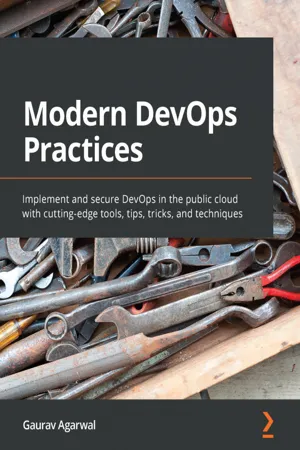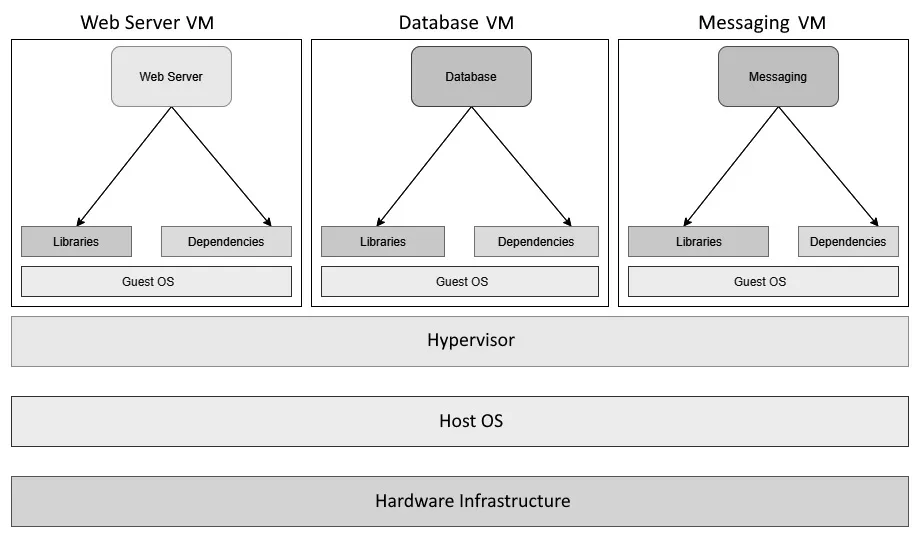
- 530 pages
- English
- ePUB (mobile friendly)
- Available on iOS & Android
Modern DevOps Practices
About this book
Enhance DevOps workflows by integrating the functionalities of Docker, Kubernetes, Spinnaker, Ansible, Terraform, Flux CD, CaaS, and more with the help of practical examples and expert tips
Key Features
- Get up and running with containerization-as-a-service and infrastructure automation in the public cloud
- Learn container security techniques and secret management with Cloud KMS, Anchore Grype, and Grafeas Kritis
- Leverage the combination of DevOps, GitOps, and automation to continuously ship a package of software
Book Description
Containers have entirely changed how developers and end-users see applications as a whole. With this book, you'll learn all about containers, their architecture and benefits, and how to implement them within your development lifecycle.You'll discover how you can transition from the traditional world of virtual machines and adopt modern ways of using DevOps to ship a package of software continuously. Starting with a quick refresher on the core concepts of containers, you'll move on to study the architectural concepts to implement modern ways of application development. You'll cover topics around Docker, Kubernetes, Ansible, Terraform, Packer, and other similar tools that will help you to build a base. As you advance, the book covers the core elements of cloud integration (AWS ECS, GKE, and other CaaS services), continuous integration, and continuous delivery (GitHub actions, Jenkins, and Spinnaker) to help you understand the essence of container management and delivery. The later sections of the book will take you through container pipeline security and GitOps (Flux CD and Terraform).By the end of this DevOps book, you'll have learned best practices for automating your development lifecycle and making the most of containers, infrastructure automation, and CaaS, and be ready to develop applications using modern tools and techniques.
What you will learn
- Become well-versed with AWS ECS, Google Cloud Run, and Knative
- Discover how to build and manage secure Docker images efficiently
- Understand continuous integration with Jenkins on Kubernetes and GitHub actions
- Get to grips with using Spinnaker for continuous deployment/delivery
- Manage immutable infrastructure on the cloud with Packer, Terraform, and Ansible
- Explore the world of GitOps with GitHub actions, Terraform, and Flux CD
Who this book is for
If you are a software engineer, system administrator, or operations engineer looking to step into the world of DevOps within public cloud platforms, this book is for you. Existing DevOps engineers will also find this book useful as it covers best practices, tips, and tricks to implement DevOps with a cloud-native mindset. Although no containerization experience is necessary, a basic understanding of the software development life cycle and delivery will help you get the most out of the book.
]]>
Frequently asked questions
- Essential is ideal for learners and professionals who enjoy exploring a wide range of subjects. Access the Essential Library with 800,000+ trusted titles and best-sellers across business, personal growth, and the humanities. Includes unlimited reading time and Standard Read Aloud voice.
- Complete: Perfect for advanced learners and researchers needing full, unrestricted access. Unlock 1.4M+ books across hundreds of subjects, including academic and specialized titles. The Complete Plan also includes advanced features like Premium Read Aloud and Research Assistant.
Please note we cannot support devices running on iOS 13 and Android 7 or earlier. Learn more about using the app.
Information
Section 1: Container Fundamentals and Best Practices
- Chapter 1, The Move to Containers
- Chapter 2, Containerization with Docker
- Chapter 3, Creating and Managing Container Images
- Chapter 4, Container Orchestration with Kubernetes – Part I
- Chapter 5, Container Orchestration with Kubernetes – Part II
Chapter 1: The Move to Containers
- The need for containers
- Container architecture
- Containers and modern DevOps practices
- Migrating to containers from virtual machines
- Understand and appreciate why we need containers in the first place and what problems they solve.
- Understand the container architecture and how it works.
- Understand how containers contribute to modern DevOps practices.
- Understand the high-level steps of moving from a Virtual Machine-based architecture to containers.
The need for containers

The matrix of hell

Virtual machines

Table of contents
- Modern DevOps Practices
- Contributors
- Preface
- Section 1: Container Fundamentals and Best Practices
- Chapter 1: The Move to Containers
- Chapter 2: Containerization with Docker
- Chapter 3: Creating and Managing Container Images
- Chapter 4: Container Orchestration with Kubernetes – Part I
- Chapter 5: Container Orchestration with Kubernetes – Part II
- Section 2: Delivering Containers
- Chapter 6: Infrastructure as Code (IaC) with Terraform
- Chapter 7: Configuration Management with Ansible
- Chapter 8: IaC and Config Management in Action
- Chapter 9: Containers as a Service (CaaS) and Serverless Computing for Containers
- Chapter 10: Continuous Integration
- Chapter 11: Continuous Deployment/Delivery with Spinnaker
- Chapter 12: Securing the Deployment Pipeline
- Section 3: Modern DevOps with GitOps
- Chapter 13: Understanding DevOps with GitOps
- Chapter 14: CI/CD Pipelines with GitOps
- Other Books You May Enjoy